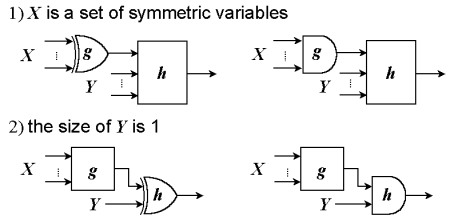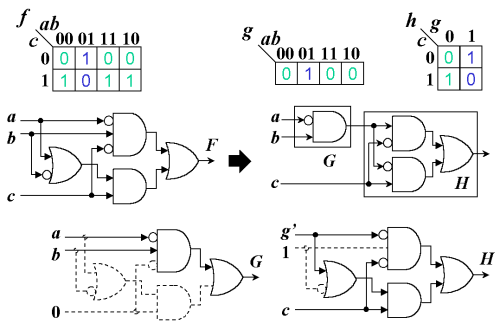Up
Logic Optimization by Effective Decompositions
Abstract
We have developed a method for a simple disjunctive decomposition,
which definitely improves the quality of a logic circuit. The method
finds decomposition forms by detecting symmetric variables and
constructs new logic circuits by utilizing the original circuit
structure.
Background
Decomposing a function f into smaller functions is a
frequent operation in logic circuit optimization. Simple disjunctive
decomposition f(X, Y) = h(g(X), Y) is a special case
where two new functions have no common variables and g
is a single-output function. It offers an optimal circuit structure
for a single-output function. Although it does not exist in all
functions, if it exists in a function, we can improve circuit quality
by detecting and applying it.
Finding Decomposition Forms
To find decomposition forms efficiently, we limit the types of
decomposition forms to be found to two as shown in Figure 1. Even if
we limit the forms in such a way, we expect that the other
decomposition forms can be found by recursively applying these
two. Actually, we have found almost all simple disjunctive
decompositions existing in given functions using this method
[1].

Fig. 1: Decomposition forms
Constructing New Circuits After Decomposition
Since operations for the decomposition are performed on the function
represented by a circuit, we do not have the new circuits
G and H that represent the new functions
g and h. It is possible for us to
construct them through an ordinary logic synthesis process from new
functions. However, the process takes a lot of time and may ignore the
good structure of the original circuit F. We have
discovered that G and H can be obtained by
simply assigning constant values to variables in the original circuit
F [2]. In Figure 2,
G is obtained by assigning 0 to c of
F. Similarly, H is obtained by assigning 1
to b of F and replacing a
with g'.

Fig. 2: Constructing new circuits
Experimental Results
In experiments using benchmark circuits, we achieved an overall
improvement of 9% in the circuit area with an execution overhead time
of several seconds.
Future Work
We will clarify the applicable domain and integrate these methods
into PARTHENON system.
References
- [1]
- Sawada, H., Yamashita, S. and Nagoya, A.: Restricted Simple
Disjunctive Decompositions Based on Grouping Symmetric Variables,
Proc. of the 7th Great Lakes Symposium on VLSI, pp. 39-44 (1997).
- [2]
- Sawada, H., Yamashita, S. and Nagoya, A.: Restructuring Logic
Representations with Easily Detectable Simple Disjunctive
Decompositions, Proc. of Design, Automation and Test in Europe
Conference 1998 (DATE '98), pp. 755-759 (1998).
Contact: Hiroshi Sawada;
Email: sawada@cslab.kecl.ntt.co.jp
Last modified: Wed Oct 14 15:54:55 1998


